oracle 1Z0-144 Exam Questions
Questions for the 1Z0-144 were updated on : Jul 08 ,2025
Page 1 out of 8. Viewing questions 1-15 out of 115
Question 1
Which two statements are true about the continue statement? (Choose two.)
- A. The PL/SQL block execution terminates immediately.
- B. The CONTINUE statement cannot appear outside a loop.
- C. The loop completes immediately and control passes to the statement after end loop.
- D. The statements after the continue statement in the iteration are executed before terminating the LOOP.
- E. The current iteration of the loop completes immediately and control passes to the next iteration of the loop.
Answer:
B E
Question 2
View the Exhibit to examine the PL/SQL code: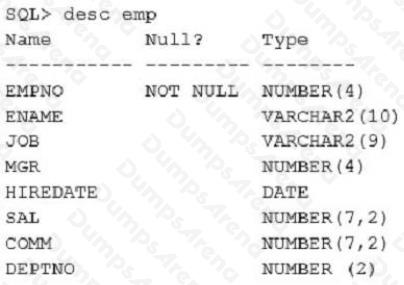
DECLARE
x NUMBER := 5; y NUMBER := NULL;
BEGIN
IF x != y THEN yields NULL, not TRUE
DBMS_OUTPUT.PUT_LINE(x != y); not run
ELSIF x = y THEN also yields NULL
DBMS_OUTPUT.PUT_LINE(x = y);
ELSE
DBMS_OUTPUT.PUT_LINE
(Cant tell if x and y are equal or not.);
END IF;
END;
/
SREVROUPUT is on for the session. Which statement is true about the output of the PL/SQL block?
- A. The output is x = y.
- B. It produces an error.
- C. The output is x != y.
- D. The output is Can't tell if x and y are equal or not.
Answer:
D
Question 3
In which of the following scenarios would you recommend using PL/SQL records?
- A. when you want to retrieve an entire row from a table and perform calculations
- B. when you know the number of elements in advance and the elements are usually accessed sequentially
- C. when you want to create a separate lookup table with multiple entries for each row of the main table, and access it through join queries
- D. when you want to create a relatively small lookup table, where the collection can be constructed in memory each time a subprogram is invoked
Answer:
A
Question 4
View the Exhibit and examine the structure of the EMP table.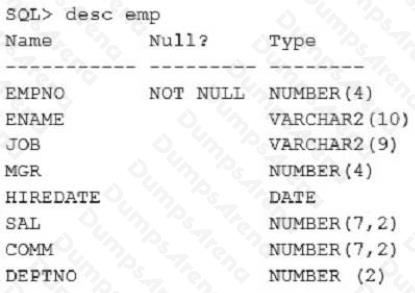
You want to create two procedures using the overloading feature to search for employee details based on either the
employee name or employee number. Which two rules should you apply to ensure that the overloading feature is used
successfully? (Choose two.)
- A. The procedures can be either stand-alone or packaged.
- B. The procedures should be created only as packaged subprograms.
- C. The procedures should be created only as stand-alone subprograms.
- D. Each subprogram's formal parameters should differ in both name and data type.
- E. The formal parameters of each subprogram should differ in data type but can use the same names.
Answer:
B E
Question 5
Which two statements are true about anonymous blocks and named subprograms? (Choose two)
- A. Subprograms are by default executed with definer's rights.
- B. The declare section is optional for both anonymous blocks and subprograms.
- C. Both anonymous blocks and subprograms execute by default with invoker's rights.
- D. The declare section is mandatory for anonymous blocks and optional for subprograms.
Answer:
A B
Question 6
View the Exhibit to examine the PL/SQL code.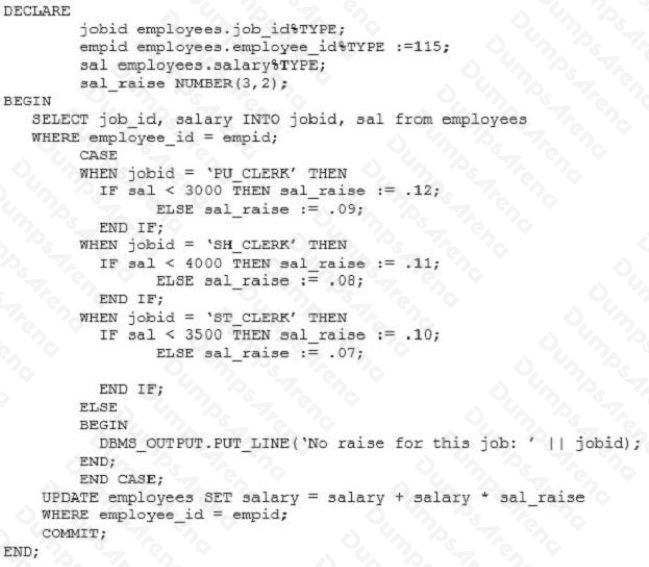
SERVEROUTPUT is on for the session.
Which statement is true about the execution of the code?
- A. The execution fails because of the misplaced else clause.
- B. The execution is successful even if there is no employee with EMPLOYEE_ID 115.
- C. The execution fails and throws exceptions if no employee with EMPLOYEE_ID 115 is found.
- D. The execution is successful, but it displays an incorrect output if no employee with EMPLOYEE_ID 115 is found.
Answer:
C
Question 7
Which two statements are true about the %ROWTYPE attribute? (Choose two.)
- A. It is used to declare a record that can hold multiple rows of a table.
- B. The attributes of fields in the record with the %ROWTYPE attribute can be modified manually.
- C. The attributes of fields in the record take their names and data types from the columns of the table, view, cursor, or cursor variable.
- D. It ensures that the data types of the variables that are declared with the %ROWTYPE attribute change dynamically when the underlying table is altered.
Answer:
C D
Question 8
View the Exhibit and examine the structure of the EMP table.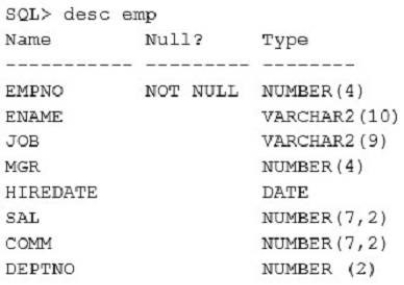
Examine the following block of code:
Which stages are performed when the above block is executed? (Choose all that apply.)
- A. Bind
- B. Parse
- C. Fetch
- D. Execute
Answer:
C
Explanation:
Reference
https://www.ibm.com/support/knowledgecenter/en/SS6NHC/com.ibm.swg.im.dashdb.apdv.plsql.doc/doc/c0053844.html
Question 9
View Exhibit 1 and examine the structure of the EMP and DEPT tables.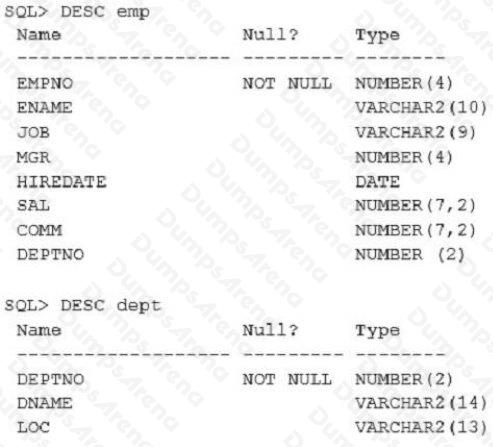
View Exhibit 2 and examine the trigger code that is defined on the DEPT table to enforce the update and delete restrict
referential actions on the primary key of the DEPT table.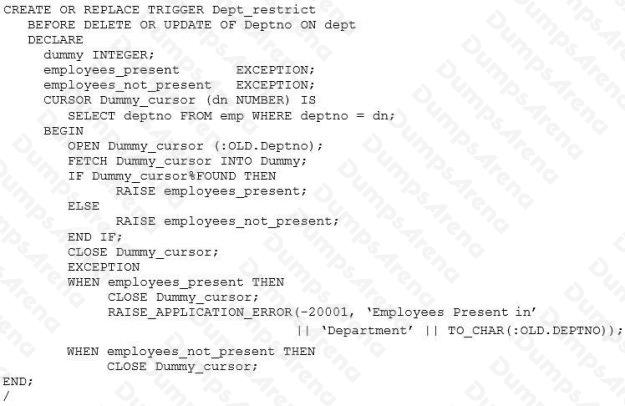
What is the outcome on compilation?
- A. It compiles and executes successfully.
- B. It gives an error on compilation because it is not a row-level trigger.
- C. It gives an error on compilation because the exception section is used in the trigger.
- D. It compiles successfully but gives an error on execution because it is not a row-level trigger.
Answer:
B
Question 10
View the Exhibit and examine the structure of the employees table.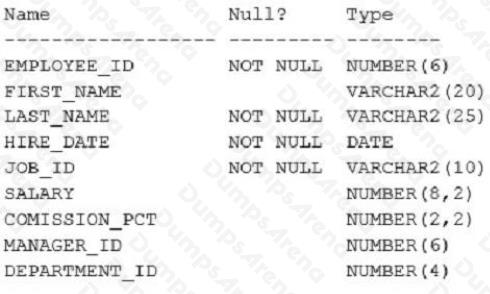
Execute the following block of code: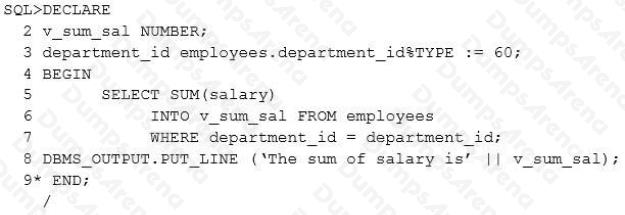
What is the outcome?
- A. It gives an error because group functions cannot be used in anonymous blocks.
- B. It executes successfully and correctly gives the result of the sum of salaries in department 60.
- C. It executes successfully and incorrectly gives the result of the sum of salaries in department 60.
- D. It gives an error because the variable name and column name are the same in the where clause of the select statement.
Answer:
C
Question 11
Examine the following code that you plan to execute: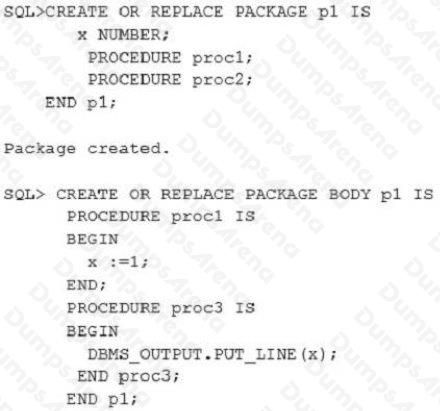
What correction should be performed in the above code?
- A. The PROC2 procedure code should be defined in the package body.
- B. The PROC3 procedure should be declared in the package specification.
- C. The PROC3 procedure header should be declared at the beginning of the package body.
- D. The variable x must be declared in the package body and removed from the specification,
Answer:
A
Question 12
View the exhibit and examine the structure of the products table.
Examine the following code: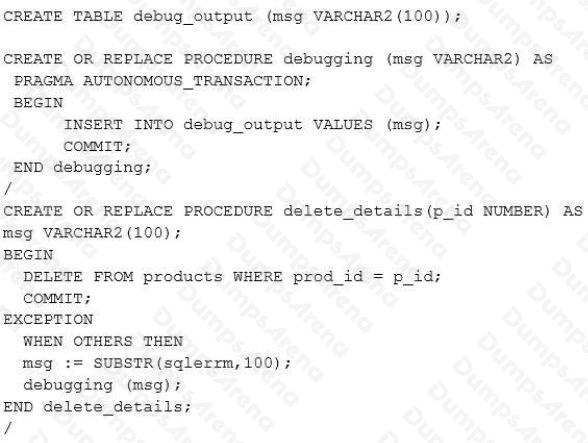
Which statement is true when the procedure DELETE_DETAILS is invoked?
- A. It executes successfully but no error messages get recorded in the DEBUG_OUTPUT table
- B. It executes successfully and any error messages get recorded in the DEBUG_OUTPUT table.
- C. It gives an error because PRAGMA AUTONOMOUS_TRANSACTION can be used only in packaged procedures.
- D. It gives an error because procedures containing PRAGMA AUTONOMOUS_TRANSACTION cannot be called from the exception section.
Answer:
A
Explanation:
In this case, the debug output will only occur if there is an exception.
Question 13
Which two statements are correct about PL/SQL package components? (Choose two)
- A. A package must have both specification and body.
- B. A package body can exist without the package specification.
- C. A package specification can exist without the package body.
- D. When a packaged public variable is called for the first time in a session, the entire package is loaded into memory.
Answer:
C D
Question 14
Examine the following snippet of PL/SQL code: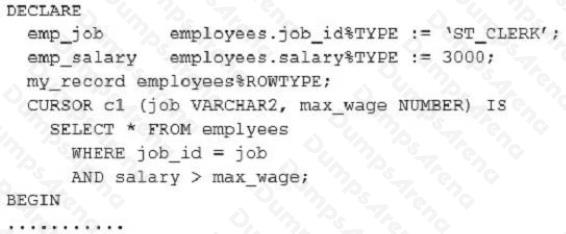
View the exhibit for table description of EMPLOYEES table. The EMPLOYEES table has 200 rows.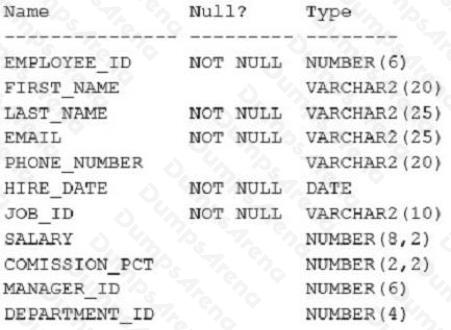
Identify open statement for opening the cursor that fetches the result as consisting of employees with JOB_ID as
ST_CLERK and salary greater than 3000.
- A. OPEN c1 (NULL, 3000);
- B. OPEN c1 (emp_job, 3000);
- C. OPEN c1 (3000, emp_salary);
- D. OPEN c1 (‘ST_CLERK’, 3000)
- E. OPEN c1 (EMP_job, emp_salary);
Answer:
B D E
Question 15
Which statement is true about triggers on data definition language (DDL) statements?
- A. They can be used to track changes only to a table or index.
- B. They can be defined by all users in the database or only by a specific user.
- C. They are fired only when the owner of the object Issues the DDL statement.
- D. They can be used to track changes to a table, table space, view, or synonym.
Answer:
D